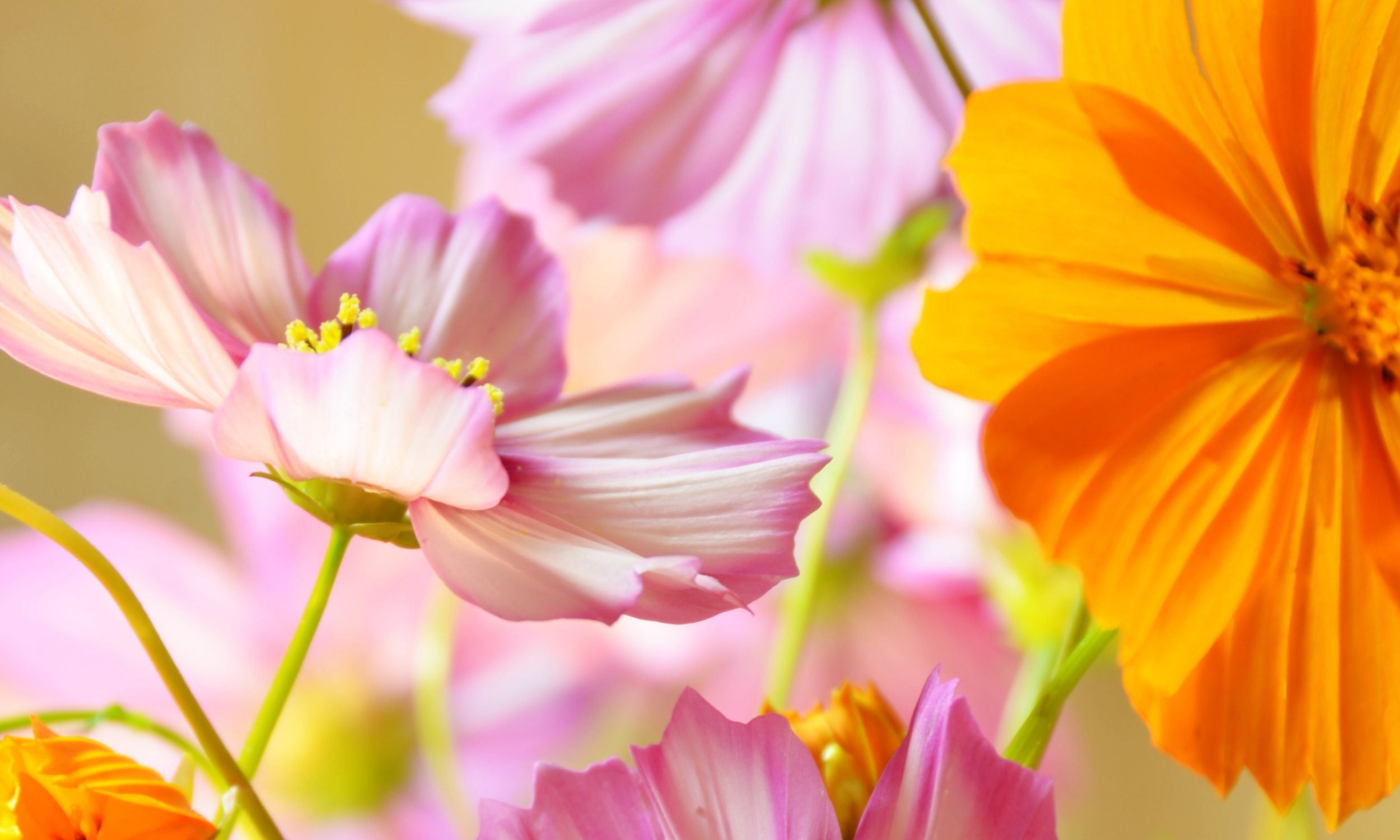How to Grow Cosmos
They are annual flowers with colorful daisy-like flowers that sit atop long slender stems. Blooming throughout the summer months, they attract birds, bees, and butterflies to your garden. Growing easily from seeds, cosmos even survive in poor soil conditions! Here’s how to grow cosmos.
Cosmos truly are a cut-and-come-again flower: The more you harvest them, the more they bloom. A single planting will produce buckets of airy, delicate, daisy-like blossoms for many months. You can arrange them on their own or weave them into mixed bouquets. The possibilities are endless.
Cosmos produce 3- to 5-inch daisy-like flowers in various colors, including pink, orange, red and yellow, white, and maroon. Their flowerheads may be bowl– or open cup–shaped. These beautiful plants can reach 6 feet tall.
Disclosure: Some of the links below are affiliate links, meaning, at no additional cost to you, I will earn a commission if you click through and make a purchase.
Planting
Seeds can be started indoors to get a jump-start on the season or sown directly into garden beds once the weather warms. Either way, cosmos will bloom in just under 3 months from the date you sow them.
Just sow seeds lightly—about ¼-inch deep. Cosmos don’t need any special soil preparation. In fact, they like soil that is not too rich, as rich soil will encourage foliage at the expense of bloom.
To start indoors, sow seeds 4 to 5 weeks before the last spring frost, then plant seedlings into the garden once all danger of frost has passed. Be careful not to sow seed too early, because seedlings will quickly outgrow their pots before the weather has warmed enough to put them out into the garden.
Alternatively, you can sprinkle seeds in your garden once danger of frost has passed. In about a week, you’ll see seedlings sprout up from the soil. Keep the young plants protected from slugs and snails as they are getting established since new growth is quite tender.
Plants get very bushy and prefer a little extra room to spread out, so space plants 12 to 18 inches (30.5 to 46 cm) apart. Once in the ground, cosmos will grow rapidly, so be sure to stake them early, while they are still young. Cosmos also benefit from a technique called pinching, as this will encourage the already highly productive plants to branch even more vigorously.
Here’s how it’s done: When plants are young, between 8 to 12 inches (20 to 30.5 cm) tall, take sharp pruners and snip the top 3 to 4 inches (7.5 to 10 cm) off the plant, just above a set of leaves. This signals the plant to send up multiple stems from below where the cut was made, resulting in more abundant flower production as well as longer stem length.
I typically do two sowings of cosmos, a month apart. This gives me a wide range of flower types and loads of blooms for cutting from summer into fall. I list some of my favorites here.
Cosmos flowers can tolerate warm, dry weather. They are even drought-tolerant.
If you let the spiky-brown seed heads blow away during the fall, cosmos might self-sow throughout your garden.

Choosing Seeds-
Nearly every type of Cosmos can be used to cut flower use, but there are some varieties
that have been bred specifically for cut flower use. Some Cosmos have “single” petals, while others have “double” petals. Some Cosmos even have petals that look like cupcake liners! Most Cosmos grow quite tall, often reaching 4’ tall, but recently new shorter varieties have been introduced. Make sure you purchase varieties that reach at least 24” tall. Cosmos bipinnatus is the class of Cosmos that includes the Cosmos you are familiar with. However, Cosmos sulphureus, known as “Sulfer Cosmos”, are another great addition to the cutting garden. They come in shades of bright yellow and orange.
Here are some of my favorite varieties
- “Double Click” Series (all are beautiful,but I especially like the “Double Click Bicolor Pink”)
- “Picotee” (beautiful bicolor blooms)
- “Versailles” (classic, sturdy variety bred specifically for cut flower use)
- “Bright Lights” (Sulfer Comsos)
- “Xsenia” (gorgeous color, stems are short)
- “Xanthos” (unusual pale yellow, stems are short)
Care
In order to prolong flowering, you should deadhead the plants (remove the dead/faded flowers). This speeds up flower development and aids branching.
Because some of these plants can grow really tall, staking may be necessary. Offer them protection from strong winds, encourage balanced branching by pinching out central shoots or stem tips, or stake them. Growing them against a fence can also provide the necessary support.
Water regularly, but make sure you don’t over-water the plants. Over-watering and over-fertilization can lead to plants with fewer flowers. Cosmos can tolerate dry soil, even in a hot, arid, sunbaked spot.
Cosmos beds may become weedy due to the fact that they self-seed, so remember to check them.

Grow Cut Flowers
Get Started NOW Bundle
How to Plant Beautiful Bouquets eBook (what to plant to great stunning bouquets). Garden Planner & Journal (planning pages to help you stay organized in the garden).
Harvesting-
Many people say that Cosmos don’t last in the vase… but this is because they are harvesting at the blooms too late. Once a Cosmos bloom opens, it is pollinated by bees. Once pollinated, the flower quickly drops its petals so it can begin its next stage of life – forming seeds. For long lasting blooms, you must cut Cosmos BEFORE the blooms have been pollinated, looking for buds that are cracking open or just opened. When harvested at this stage, you can expect them to open up in the vase over the next 5-7 days. As with all cut flowers, be sure to cut deeply into the plant between 2 sets of leaves, cutting stems at least 18” long. Each stem should have multiple blooms/buds, a “spray” of flowers. Deep cuts signal the plants to produce MORE flowers to replace the one you just cut. This is especially important with Cosmos, as they tend to become a tangled mess if you don’t make deep cuts!
As always, harvest flowers in the cool of the day (morning or evening). Immediately upon harvest, I usually place flowers in a cool dark space to keep them in top condition. Cosmos require no other special treatment.
For a small investment of time and this how to grow cosmos guide, you will be able to fill your house with these cheerful flowers all summer long.

Do you grow cosmos or plan to add them to your garden this coming season? If so, what are your favorite varieties?
Lastly, if you find this information is helpful, I would love it if you would share it with your friends.
What’s Next?
Learn more about cut flowers by visiting- Everything Cut Flowers.
Learn about Zinnias by visiting – How to Grow Zinnias.
